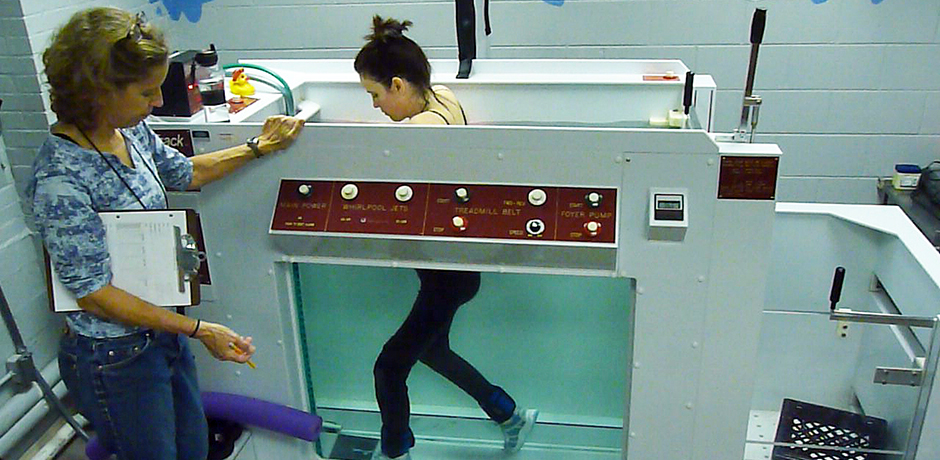For three years, Middle Tennessee State University’s exercise science experts have worked wonders with people who suffer from incomplete spinal cord injuries.
Now the National Institutes of Health is giving them an opportunity that could change the way health professionals treat these patients, who retain some preservation of sensation or motor function at the lowest segment of the spinal cord.

Carmen Thompson of Nashville works out on an underwater treadmill in MTSU’s Alumni Memorial Gym while Dr. Sandy Stevens, left, watches. Thompson was paralyzed when a two-ton A-frame structure fell on top of her in 2007 accident. (MTSU file photo by J. Intintoli)
With a $388,894 grant from the federal agency, Drs. Don Morgan and Sandy Stevens will conduct a comprehensive study beginning in fall 2014 by recruiting, testing and following up with clients suitable for walking in MTSU’s underwater treadmill laboratory.
Thirty participants, including part of a control group, will help the university scientists determine the impact of underwater treadmill training on partially paralyzed individuals’ mobility, health and quality of life.
“We can improve their leg strength,” said Morgan, a professor of exercise science in the university’s Department of Health and Human Performance.
“We can improve their balance. We can reduce the need for external help when they walk.”
The primary goals are to improve the participants’ mobility, reduce physical inactivity, increase their participation in life activities and improve aerobic fitness.
Over a 16-week period, the participants’ gait patterns will be tracked. They’ll be videotaped and will have electrodes attached to their bodies. These electrodes will enable researchers to determine if the activity and coordination of their leg muscles change after the aquatic walking program.

Dr. Don Morgan

Dr. Brian Hinote
Dr. Brian Hinote, an associate professor of sociology, will evaluate the participants’ lifestyles before and after the treadmill trials.
“We want to assess the degree to which the people are able to carry on the activities of their daily lives, both at home and in their communities,” Hinote said.
Morgan’s earlier research with the underwater treadmill focused on children with cerebral palsy. The results were promising enough to lead him to believe it could work for other populations, including diabetics and stroke survivors.
“It could certainly be a complementary therapeutic technique that, for some, could really spell the difference between being able to be mobile on land instead of being relegated primarily to a wheelchair or a walker,” Morgan said.
Stevens, an assistant professor of exercise science, works most directly with the clients, transferring them safely into the treadmill, adjusting the water temperature and adjusting the height of the tank for the armrests.
She knows that while restoring their full mobility might not be possible, their mobility can be increased.
“It really is possible to restore that level of independent functioning, and a lot of it can be done through fairly low-tech interventions that could potentially be done within a community,” Stevens said.
You can watch an archived video about the underwater treadmill research program below.
Part of the NIH funding will pay undergraduate and graduate students to assist with the study. It’s a move that will better prepare MTSU graduates for jobs in the health professions and improve the university’s research profile, the professors said.
Morgan and Stevens will speak directly to students during fall classes to help choose the lucky few assistants. They said they expect the humanitarian aspect of the work to be a major selling point.
“You have a chance to impact the lives of people in a positive way, and that is incredibly fulfilling,” Morgan said.
The NIH-funded study is noteworthy for a university not connected to a college of medicine or a teaching hospital, and Morgan is encouraged by the agency’s approval of MTSU’s proposal.
“We’re doing work here at MTSU that, as far as I know, is not being done anywhere else in the world at this level,” said Morgan.
For more information about the program, contact Morgan at 615-898-5549 or don.morgan@mtsu.edu or Stevens at 615-494-7905 or sandra.stevens@mtsu.edu.
You also can read the personal stories of clients who’ve used the underwater treadmill project to help increase their mobility in this story published in the April 2014 edition of “MTSU Magazine.”
— Gina K. Logue (gina.logue@mtsu.edu)

Richard Locke of Murfreesboro works out on an underwater treadmill in MTSU’s Alumni Memorial Gym. Locke, who suffered a stroke that affected muscle ability on the left side of his body, is one of several clients who have benefitted from research conducted by MTSU’s exercise science professionals. (Photos by MTSU Office of News and Media Relations)

Richard Locke works to improve his gait while walking on an underwater treadmill in MTSU’s Alumni Memorial Gym.


COMMENTS ARE OFF THIS POST